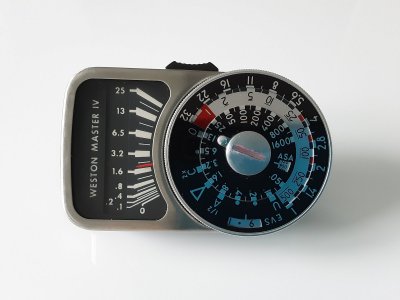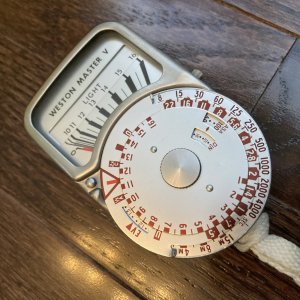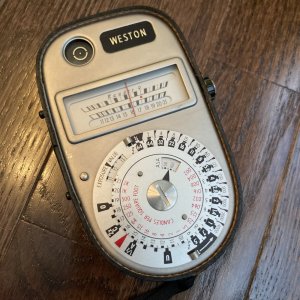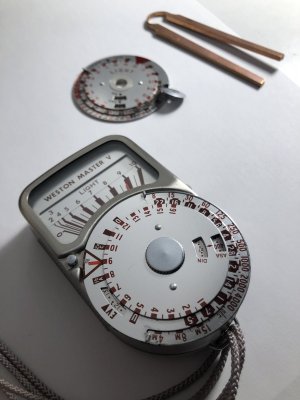DownUnder
Nikon Nomad
Oddly, I see more Weston Master IIs and IIIs still in use than Vs or the newer, later models. Were those '40s-early '50s models built to a more robust standard? Not that I see that many, but well, you know. We all know. Afficionados. Cute, but not really a good match with a Nikon Zf, after all.
This thread has made me want to take out my collection of Westons, dust them off, and actually use them. I've let them lie fallow for much too long. I'm in Brunei now, but when I'm home again in a few weeks, out they will come, to be taken out for a good airing and testing.
This said, when they eventually expire, that will be it. No restoring. On the display shelf they'll go.
Thanks to this thread and a few canny posts, I'm now on the hunt for the earliest Weston models from the 1930s. To add to my display.
As some actress in Hollywood once said in an old, old film, "what a GAS!"
This thread has made me want to take out my collection of Westons, dust them off, and actually use them. I've let them lie fallow for much too long. I'm in Brunei now, but when I'm home again in a few weeks, out they will come, to be taken out for a good airing and testing.
This said, when they eventually expire, that will be it. No restoring. On the display shelf they'll go.
Thanks to this thread and a few canny posts, I'm now on the hunt for the earliest Weston models from the 1930s. To add to my display.
As some actress in Hollywood once said in an old, old film, "what a GAS!"
Chriscrawfordphoto
Real Men Shoot Film.
Oddly, I see more Weston Master IIs and IIIs still in use than Vs or the newer, later models. Were those '40s-early '50s models built to a more robust standard? Not that I see that many, but well, you know. We all know. Afficionados. Cute, but not really a good match with a Nikon Zf, after all.
This thread has made me want to take out my collection of Westons, dust them off, and actually use them. I've let them lie fallow for much too long. I'm in Brunei now, but when I'm home again in a few weeks, out they will come, to be taken out for a good airing and testing.
This said, when they eventually expire, that will be it. No restoring. On the display shelf they'll go.
Thanks to this thread and a few canny posts, I'm now on the hunt for the earliest Weston models from the 1930s. To add to my display.
As some actress in Hollywood once said in an old, old film, "what a GAS!"
I've never seen a Weston Master IV or V that worked at all unless it has been recently serviced. They ALL have dead cells. I've never seen a Weston Master (the original), Master II, or Master III with a dead cell, though many of them are no longer accurate. I don't know why that is. The older Westons are bigger and heavier then the later ones; probably made with better materials.
Russell W. Barnes
Well-known
Well, every good rule has a notable exception.I've never seen a Weston Master IV or V that worked at all unless it has been recently serviced. They ALL have dead cells.
wolves3012
Mentor
Another exception here. Had mine about 15 years or so, agrees well with other meters I have. It's not been serviced in my ownership. Interestingly, this page's author says it's the most reliable bit of gear he's owned:I've never seen a Weston Master IV or V that worked at all unless it has been recently serviced. They ALL have dead cells.
Attachments
Russell W. Barnes
Well-known
Made a mistake! Damn... Mine is a Weston Master III, not a IV. But yes, it works as described.Well, every good rule has a notable exception.My Weston-Master IV works a treat and compares favourably with my iPhone light meter app.
Age is a dreadful thing...
DownUnder
Nikon Nomad
I agree, sort of. My trio are rare exceptions. The older III works better than the two Vs.I've never seen a Weston Master IV or V that worked at all unless it has been recently serviced. They ALL have dead cells. I've never seen a Weston Master (the original), Master II, or Master III with a dead cell, though many of them are no longer accurate. I don't know why that is. The older Westons are bigger and heavier then the later ones; probably made with better materials.
I was a late comer to Westons as I now recall (with a little help from my old photo diaries) buying the pair in a secondhand shop in Sydney (Australia) in 1983 and 1984, for AUD $35 each which back in the day was serious money for me. The III I acquired in the early '00s from a deceased estate sale.
Admittedly they are now more antiques and photo shelf queens than useful, tho' as with all my photo year I try to get out and about with them and actually make use of them, once every year. So far, still do. They look good and feel good to use, unlike their user.
So yes, I make use of them (on sunny days). As for their accuracy, well, let's not go there, please. I will say only I'm ever thankful for the latitude in exposure we get in modern day negative films...
Leicabimmer
Newbie
Hello- I have a Master V in perfect working order and a water damaged Euromaster in not so working order. I noticed you replaced the Master V dial with one from a Euromaster which is something wanted to do as well but unlike the Master V, the Euromaster has a slightly different method of affixing itself to the body. There Is a light grey “plug” at it’s center(possibly covering a screw) unlike the Master V which is knurled. How did you go about removing the dial?They’re very nice meters. I found a really clean master V and put a Euromaster dial on it then had George at QLM rebuild it. Even though it was working he put a new cell in it and new grid. For lack of a better term I refer to the perforated flap that goes over the cell for low and high range. George also demagnetized the magnet in the meter movement. It works perfect and I carry it often.
An even better meter is the Westin Ranger 9. Again I found a clean working example and sent it to QLM whh by ere George Milton reworked, calibrated and converted it to a modern battery.
Neither meters were that cheap to refurb but there’s nothing on the market today comparable so I feel it was well worth the cost.
Unfortunately George retired and closed QLM and I’m not sure there’s a comparable service now.
x-ray
Mentor
Excellent! Does it seem to be accurate? I have the incident dome but only use it in a pinch but for reflective readings, It’s one of the best general purpose meters I’ve found.As a result of your recommendation, I got myself a very nice Weston Ranger 9. $18 plus $6 shipping.
Weston Ranger 9 by Vince Lupo, on Flickr
Fortunately I already had two of the MR-9 battery adapters and this meter is right on the money. The only thing that I don't have for it is the incident cover, but I think I can suffer without it.
Vince Lupo
Nobody's Mentor
Yes it works perfectly and is very accurate. I made sure to use one of those Kanto Camera MR-9 adapters with a 301/386 battery.Excellent! Does it seem to be accurate? I have the incident dome but only use it in a pinch but for reflective readings, It’s one of the best general purpose meters I’ve found.
As mentioned the only thing I don't have with it is the diffuser dome for incident readings.
x-ray
Mentor
Here’s a photo of my hybrid V. As I recall the dial from the Euro directly fit the V. I believe I swapped the screw that secures it but basically they’re the same. I do remember I’m pretty sure I didn’t have to make any modifications.Hello- I have a Master V in perfect working order and a water damaged Euromaster in not so working order. I noticed you replaced the Master V dial with one from a Euromaster which is something wanted to do as well but unlike the Master V, the Euromaster has a slightly different method of affixing itself to the body. There Is a light grey “plug” at it’s center(possibly covering a screw) unlike the Master V which is knurled. How did you go about removing the dial?
The Euromaster dial is a huge improvement imo.
Attachments
x-ray
Mentor
If you can find a working and accurate Ranger 9 they’re worth picking up. Prices range from giveaway to crazy but it’s a crapshoot as to whether they’ll work. They’re CDS meters so they don’t die like selenium cells but batteries don’t exist now so you’ll need to pickup a couple of the SR9 adapters or get it updated for newer batteries.
Attachments
x-ray
Mentor
Update to my previous post— the battery adapter is NOT an SR-9 but as Vince pointed out it’s an MR-9. They drop the voltage of the 301/386 battery to the correct voltage and batteries are readily available and cheap.
Leicabimmer
Newbie
Thanks X-Ray! Success! Removed the thin cover screw with a spanner similar to the one in the photo with great difficulty.Here’s a photo of my hybrid V. As I recall the dial from the Euro directly fit the V. I believe I swapped the screw that secures it but basically they’re the same. I do remember I’m pretty sure I didn’t have to make any modifications.
The Euromaster dial is a huge improvement imo.
Attachments
DownUnder
Nikon Nomad
A timely warning to the home repair addicts.
I would hate to take apart one of my beloved Westons, to then discover I had no idea as to how to put them back together again. This is basically me, but I suspect it applies to many more of us than we would care to admit.
Otherwise, again relating to the Weston Vs, a stray thought just crossed my b-cells...
Before you rip your Weston Vs to bits, try turning the small screw in the back a little both ways. In the past, when two of my three Vs ceased to function, I found this activated the cell and the needles began working again. Not eternally, but for a fairly long while, until age claimed them and they again went belly up on me. One still works, and I treasure it. The other two are shelf queens.
Oddly, my Weston II and II go on and on working and amazingly, read almost accurately. I have no explanation for this, but given their advanced age (70+ years) it amazes me.
Again, I draw attention to the fact that while the Vs have this screw at the back, the earlier models (Its and IIIs) may not. I am currently traveling overseas and not at home, so I cannot check my oldies to see if they do or not. So this is my disclaimer, sort of.
Not exactly scientific or even basic rocket science, but as a first attempt at a fix, it's worth trying.
I would hate to take apart one of my beloved Westons, to then discover I had no idea as to how to put them back together again. This is basically me, but I suspect it applies to many more of us than we would care to admit.
Otherwise, again relating to the Weston Vs, a stray thought just crossed my b-cells...
Before you rip your Weston Vs to bits, try turning the small screw in the back a little both ways. In the past, when two of my three Vs ceased to function, I found this activated the cell and the needles began working again. Not eternally, but for a fairly long while, until age claimed them and they again went belly up on me. One still works, and I treasure it. The other two are shelf queens.
Oddly, my Weston II and II go on and on working and amazingly, read almost accurately. I have no explanation for this, but given their advanced age (70+ years) it amazes me.
Again, I draw attention to the fact that while the Vs have this screw at the back, the earlier models (Its and IIIs) may not. I am currently traveling overseas and not at home, so I cannot check my oldies to see if they do or not. So this is my disclaimer, sort of.
Not exactly scientific or even basic rocket science, but as a first attempt at a fix, it's worth trying.
Last edited:
former of the herd
Newbie
I never used one, but Westons do have a following. Do you have other light meters to use I hope?
former of the herd
Newbie
You make a good point. After a while I hit on the idea to not only make notes but take photos with a P&S digital or my phone. Even so, I was always scared to start again.A timely warning to the home repair addicts.
I would hate to take apart one of my beloved Westons, to then discover I had no idea as to how to put them back together again. This is basically me, but I suspect it applies to many more of us than we would care to admit.
Otherwise, again relating to the Weston Vs, a stray thought just crossed my b-cells...
Before you rip your Weston Vs to bits, try turning the small screw in the back a little both ways. In the past, when two of my three Vs ceased to function, I found this activated the cell and the needles began working again. Not eternally, but for a fairly long while, until age claimed them and they again went belly up on me. One still works, and I treasure it. The other two are shelf queens.
Oddly, my Weston II and II go on and on working and amazingly, read almost accurately. I have no explanation for this, but given their advanced age (70+ years) it amazes me.
Again, I draw attention to the fact that while the Vs have this screw at the back, the earlier models (Its and IIIs) may not. I am currently traveling overseas and not at home, so I cannot check my oldies to see if they do or not. So this is my disclaimer, sort of.
Not exactly scientific or even basic rocket science, but as a first attempt at a fix, it's worth trying.
Coldkennels
Barnack-toting Brit.
Honestly, it'd be nigh-impossible to dismantle a Weston and not know how to put it back together. They're fairly straightforward things; the worst you could do is use the wrong (or just a bad) screwdriver and ruin a screw head. A good set of Wera precision screwdrivers of differing sizes will prevent that.
@DownUnder, that screw at the back is the adjustment screw to re-zero the meter; I can't see any way twiddling with it would bring a Weston back to life unless something was mis-aligned inside.
@DownUnder, that screw at the back is the adjustment screw to re-zero the meter; I can't see any way twiddling with it would bring a Weston back to life unless something was mis-aligned inside.
Dralowid
Michael
When I was young and in and out of pro studios in London, Weston's were everywhere and treated almost like disposable items. They had a hard life. I reckon the older black ones have survived so well because they were not in the same sort of environment...ie they were privately owned. For some reason I still have four of the things, II, IV, V etc and they all give more or less the same reading.
DownUnder
Nikon Nomad
Well, maybe. Or maybe not. You've never met me. If you had, you would know.Honestly, it'd be nigh-impossible to dismantle a Weston and not know how to put it back together. They're fairly straightforward things; the worst you could do is use the wrong (or just a bad) screwdriver and ruin a screw head. A good set of Wera precision screwdrivers of differing sizes will prevent that.
@DownUnder, that screw at the back is the adjustment screw to re-zero the meter; I can't see any way twiddling with it would bring a Weston back to life unless something was mis-aligned inside.
In my usual un-rocket science way, I can only reply to your pot by saying I giggle that screw, and my Westons start working again. Zeroing the meter involves moving the needles about, however lightly it does it. So an act of the universe, maybe. But it works, and that's good enough for me.
A cautionary tale here. I once took apart the keyboard on one of my old laptops, to clean the thing after one of our cats knocked part of a cup of coffee into it.
By the time I had finished I had enough bits left over to fill a small coffee cup. Our local repair tech charged me half the price I paid for the laptop (admittedly secondhand, like almost everything I buy) to put it all back together again.
But to give him his due, and mine, he did have about four bits left after the reassembly. One looks to me like a cat claw.
So yes, no way would I never take apart a Weston. Respectfully, the very best of my good wishes for luck to you if you ever do.
Share:
-
This site uses cookies to help personalise content, tailor your experience and to keep you logged in if you register.
By continuing to use this site, you are consenting to our use of cookies.






